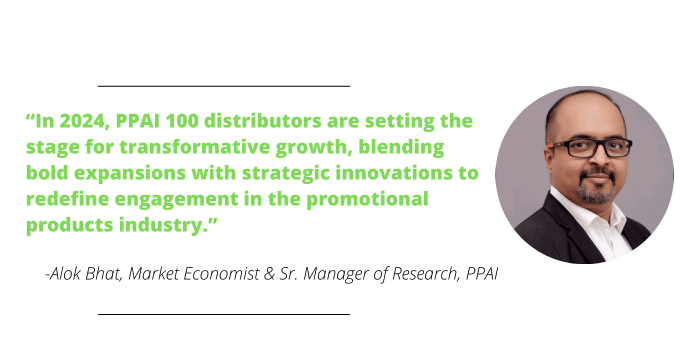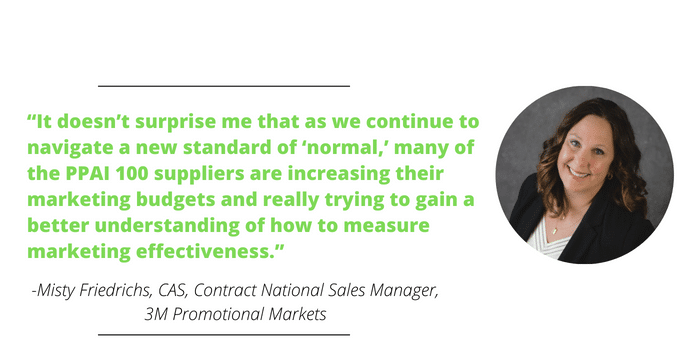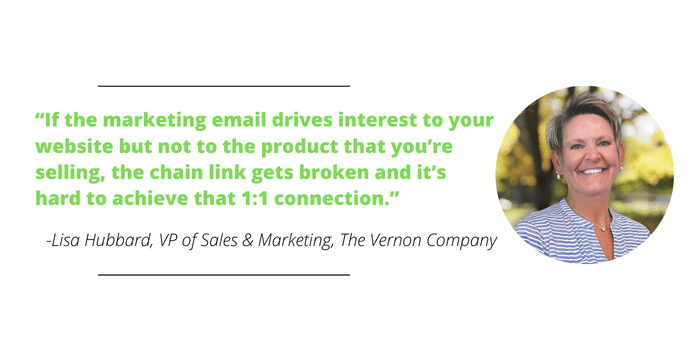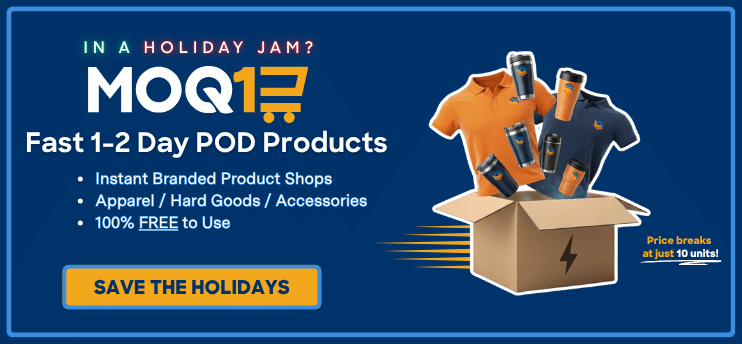As anyone who has ever attended The PPAI Expo can attest, trade shows remain the most effective marketing channel for promotional products professionals.
According to a new survey of PPAI 100 companies conducted by PPAI Research, about two-thirds (67%) of distributors and 84% of suppliers report that trade shows and events delivered the best return on investment (ROI) in 2023, underscoring the value of personal interactions and live product demonstrations in building relationships and closing deals.
Email marketing (67%) was also effective for PPAI 100 distributors, followed by content marketing (57%), social media (48%), self-promo products (48%) and digital advertising (38%).
- Not surprisingly, traditional marketing channels like direct mail (10%) and print advertising (5%) provided limited impact.

Email marketing (58%) also stood out as highly effective for PPAI 100 suppliers, followed by social media (47%), content marketing (32%) and self-promo products (26%).
- Print advertising (16%) and digital advertising (11%) played a role for some suppliers, albeit less significantly compared to other channels.
“The 2023 marketing landscape for PPAI 100 distributors and suppliers showcases a strategic embrace of both digital and traditional engagement channels, emphasizing a diversified approach to maximize outreach and deepen customer connections in the promotional products industry,” says Alok Bhat, market economist and senior manager of research at PPAI.
2024 Marketing Budget Forecast
This year, most promo companies are planning new marketing initiatives in 2024, some quite significant. Budgets are largely holding steady, or showing moderate growth, to support them.
More than half (52%) of PPAI 100 distributors report that they’re maintaining their current marketing budget levels in 2024, indicating a cautiously optimistic approach by focusing on maximizing the ROI from existing strategies. That still leaves 48% of PPAI 100 distributors planning to either moderately or significantly increase their marketing budget this year.
- In 2024, 76% of distributors are planning to introduce new marketing initiatives, indicating a more measured, yet proactive approach to integrating fresh strategies alongside proven methods, Bhat says.
- Bhat notes that the 24% poised to significantly expand their marketing initiatives are signaling an aggressive approach to not only capture market share, but also engage with new and existing audiences more deeply.
“In 2024, PPAI 100 distributors are setting the stage for transformative growth, blending bold expansions with strategic innovations to redefine engagement in the promotional products industry,” Bhat says. “It’s a testament to their agility and foresight in navigating the future of marketing.”

Meanwhile, 55% of PPAI 100 suppliers are planning a moderate increase in their marketing budget for 2024. Additionally, more than one-third (36%) of PPAI 100 suppliers report gearing up for a substantial expansion of their marketing efforts.
“Within the dynamic landscape of our industry, effective marketing is the linchpin in the sales channel, and, if done correctly, can act as the engine of customer engagement, helping to foster ongoing relationships that extend beyond the initial sale,” says Misty Friedrichs, CAS, contract national sales manager at 3M Promotional Markets – ranked the No. 40 supplier in the inaugural PPAI 100.
“It doesn’t surprise me that as we continue to navigate a new standard of ‘normal,’ many of the PPAI 100 suppliers are increasing their marketing budgets and really trying to gain a better understanding of how to measure marketing effectiveness.”

However, the survey found that 36% of suppliers are keeping their marketing budgets unchanged in 2024, with 59% planning to introduce only a few new marketing initiatives this year. “At the same time, many are also keeping their new initiatives limited because it creates focus, allowing us to get a handle on what’s working and what isn’t, and to pivot more quickly when needed,” Friedrichs says.
In a stark contrast from PPAI 100 distributors, which reported no planned cuts, 9% of PPAI 100 suppliers anticipate reducing their marketing budgets in 2024, with both moderate and significant cuts being made.
- A small portion (5%) of suppliers intend to maintain their current marketing initiatives without changes, possibly reflecting satisfaction with existing results or a cautious stance given uncertain market conditions, Bhat says.
Supplier Marketing Challenges
Measuring marketing effectiveness is the number-one challenge for 65% of PPAI 100 suppliers, indicating a significant need for better tools and strategies to quantify the impact of marketing investments, Bhat says.
- Other challenges include creating engaging content (45%), identifying the right target audience (37%) and budget constraints and keeping up with marketing trends (both 15%).
The overwhelming majority (86%) of PPAI 100 suppliers say that revenue and sales impact are the top measure of a marketing campaign’s success.
- That’s followed by customer engagement metrics (77%), web traffic insights (46%), ROI precision (36%) and lead generation focus (27%).
“In the arena of promotional products, the true measure of marketing success lies in the seamless blend of tangible results and digital engagement, crafting a narrative of growth that resonates across the market landscape,” Bhat says.

Distributor Marketing Challenges
Similarly, measuring marketing effectiveness is the number-one challenge for 63% of PPAI 100 distributors.
- Other challenges include identifying the right target audience (37%), creating engaging content (32%) and keeping up with marketing trends (21%).
Measuring marketing effectiveness has been a friction point for quite some time, according to Lisa Hubbard, vice president of sales and marketing at The Vernon Company – ranked the No. 44 distributor in the inaugural PPAI 100.
“Those that want to find the ROI of every touchpoint come up short when the sequence gets broken in the chain of connection with the customer,” Hubbard says. “If the marketing email drives interest to your website but not to the product that you’re selling, the chain link gets broken and it’s hard to achieve that 1:1 connection.”

“That’s what leads to challenges like failing to identify the right target audience and not making your messaging as personalized as customers have come to expect,” Hubbard adds. “If it’s not personalized and what they want to see, customers simply won’t engage.”
The overwhelming majority (85%) of PPAI 100 distributors say that revenue and sales impact are the top measure of a marketing campaign’s success.
- That’s followed by ROI precision (80%), lead generation focus (75%), customer engagement metrics (65%) and web traffic insights (50%).
However, Hubbard stresses that it’s important to measure all interest and buying signals. “While measuring revenue is great, it’s just as important to have timely responses to the leads that marketing generates,” she says. “A/B testing your messages is critical for learning what your audience wants to engage with.”
Ultimately, the insights from PPAI 100 firms point to a pivotal shift toward strategic growth and enhanced customer engagement in 2024.
“Armed with a blend of traditional strengths and digital savvy, these leading companies are navigating challenges with innovation and adaptability, setting a dynamic course for future success in an evolving marketplace,” Bhat says.


